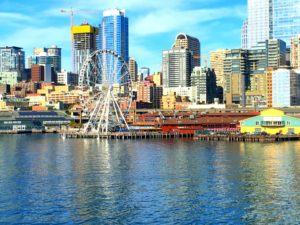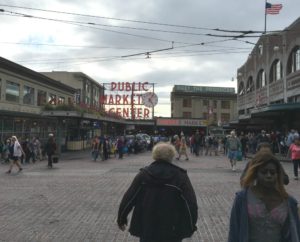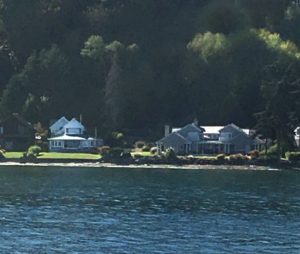BY JEFFREY WEIDEL
It doesn’t take long for a visitor to arrive at the realization that there’s a mind-blowing natural beauty to the Seattle region.
With a week to really get to know Seattle and all its many intriguing areas, guess what? Upon departure, my wife and I felt there were so many more things to explore in the Northwest’s most fascinating city.

One of the first observations regarding Seattle is water – it’s everywhere. And we’re not talking ocean. Seattle requires a long, arduous drive to the ocean and there’s not much to see once you get there. Save that trip for the beautiful and accessible California and Oregon coastlines. Seattle waterways are inlets, lakes, rivers and one humongous sound.
Yet the funny thing we discovered with many Seattle natives is they often have no idea what the nearby waterways are called. The most common answer – “Oh, that’s the (Puget) Sound.” Convenient answer, because the Sound spans 100 miles in length and 10 miles wide. However, often with a little research we found the answer to be wrong. Still, water is what makes Seattle so intrinsically beautiful.
Speaking of water, we suggest visiting Seattle in the summer. The city gets roughly 155 days of rain each year, and most of that comes mid-October through June when the temperatures often range from the mid-40s to the high 50s, and the sun makes infrequent appearances. If you’re not a fan of dreary, damp weather, make your Seattle visit in July, August or September.
Known as the “Emerald City” for Washington’s lush green forests, Seattle is a fairly clean city with generally polite but not extremely outgoing people. It has a cheap, exceptionally efficient light rail train that is terrific for getting in and out of the touristy downtown area or hoping a ride to a very busy airport.
The Seattle regional economy is fairly strong, thanks to being the home base for Boeing, Starbucks, Amazon.com, Costco and Microsoft. The University of Washington in Seattle receives more federal research money than any other school in the country.
There are numerous places to visit in the Seattle region. Below are a few suggestions.
Pike Place Market: Part of the eclectic downtown scene, the area is cool place to hang out, people watch, grab a cup of coffee at the original Starbucks (beware of long lines), sample a microbrew (Old Stove Brewery was my favorite location), and browse through the public farmers market, that got its start in 1907. The maize-like market features alleys, lower levels, stairways and can put one on sensory overload with its aromas, tastes and textures.
A 9-acre historic district, Pikes is close to the waterfront and is a terrific place to sample the fresh fish and seafood from the Pacific Northwest and Alaskan waters. Bring an appetite, because there are more than 80 restaurants and shops that specialize in various food items, including donuts. The shopping options are numerous as well, with many specialty shops, second-hand stores with collectibles and handmade art.
The market features numerous street performers and there are also homeless panhandlers. But they aren’t aggressive like the ones in San Francisco. It’s best to take light rail, rather than try to locate a parking space.

Space Needle: A visit to Seattle isn’t complete without seeing the city’s skyline from this vantage point, which happens to be the tallest (605 feet) building west of the Mississippi. A design marvel, the Space Needle observation deck resides at 520 feet and visitors are treated to a 360-degree view of the downtown and far beyond.
There’s nothing to rave about on the menu at the Space Needle restaurant, where the food and drinks are over-priced. However, a dining experience is highly recommended because it’s a fun experience, eating and drinking at 500 feet in one of the world’s two revolving restaurants.
Every seat in the dining room offers an unobstructed view of the city You might even be dining next to someone famous. Reportedly SkyCity restaurant visitors have included Elvis Presley, Mike Myers, Demi Moore, Melanie Griffith, John Travolta, Vanna White, Michael Douglas, and many more.
Taking the elevator is what most people prefer. That’s not surprising considering there’s 848 steps from the bottom of the basement to the top of the Observation Deck.
Mount Rainier National Park: Another icon in the sky to be experienced during a Seattle visit is this towering, majestic, glacier-capped mountain that is 14,410-feet high. Adding to its overall beauty, Mount Rainier may be snow-covered during a summer visit because often times the white stuff sticks around until mid-July at 5,000 to 8,000 feet.
A drive to Mount Rainier and visiting different areas of the park can be quite enjoyable. But only experienced climbers should consider a hike to the top, which involves 9,000 feet of vertical and a distance of eight miles.
Just because it’s summer doesn’t mean the weather patterns won’t be unpredictable and a little crazy. A weather change can happen quickly, resulting in high winds and even a summer blizzard. People not in good physical condition or dressed properly are headed for trouble. Each year Mount Rainier claims the lives of a few climbers.
Still, a visit can be a wonderful experience. The website says “the scale and character of Mount Rainier is more akin to an Alaskan or Andean peak. An active volcano, Mount Rainier is the most glaciated peak in the contiguous U.S., spawning six major rivers. Subalpine wildflower meadows ring the icy volcano while ancient forest cloaks Mount Rainier’s lower slopes. Wildlife abounds in the park’s ecosystems.”
Ferry riding: There are 28 vessels that serve 10 routes in Seattle and the surrounding area, making this one of the nation’s largest ferry systems. Visitors can drive, walk or bike on a ferry leaving Bremerton or Bainbridge Island – destination Seattle’s Pier 52 and the downtown area. During the summer months the views are excellent, the waterways are rarely choppy and it’s another cool way to view Seattle.

Beneath the Streets: This is a terrific way to absorb a little Seattle history. It only takes an hour and just $17 ($10 for kids) to view three city blocks of Seattle’s original neighborhood – Pioneer Square.
The underground passageways were constructed in the 1890’s, but gradually fell out of use after the city streets were elevated and a new “ground floor” was established on higher ground, eventually making Pioneer Square obsolete. Knowledgeable guides have some informative and funny tales to tell about this era in Seattle history.
Bellevue: Located across Lake Washington from Seattle, this cool kind of hip metropolitan area has been call the “boomburb.” The second largest city center in Washington state, Bellevue was named No. 1 in CNNMoney’s list of the best places to live and launch a business in 2008. Six years later, USA Today ranked Bellevue as the second-best place to live in the U.S.
People obviously were listening because 145 companies have located in Bellevue, including major players like Expedia, T-Mobile, Microsoft and Nintendo.
Bellevue is a beautiful, clean, well-designed city with lots of culture, including the Bellevue Arts Museum, Bellevue Botanical Garden, Mercer Slough Nature Park, and other some other great attractions. Inspired by European-style shopping, The Shops at the Bravern has beautiful architecture, gorgeous flowerbeds, fountains, and fashionable places to shop like Neiman Marcus, Gucci, Prada, Jimmy Choo, and Louis Vuitton.
If you’re looking for something low key, try Meydenbauer Beach Park. Situated in downtown Bellevue, the 2.5-acre park is located on the shores of Lake Washington. The park is set on 2.5 acres and is ideal for walking or spreading out a blanket and having a picnic.
Jeffrey Weidel is a freelance writer from the Sacramento region. To contact him, email skiweidel@gmail.com.